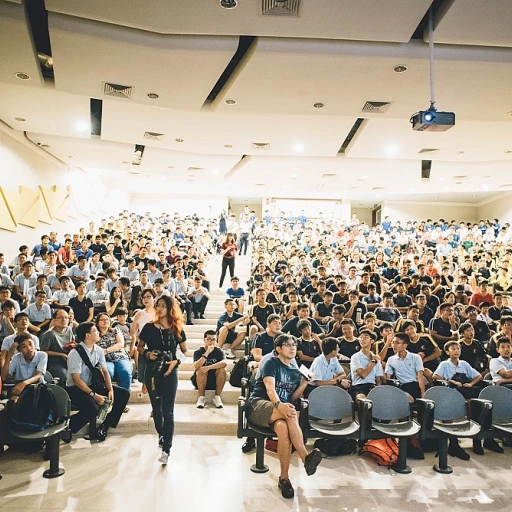The Heartbeat of Employee Engagement
The Core of Connection
Employee feedback is not just a communication tool; it is the lifeline that keeps organizations thriving and engaged. By aligning employee feedback with organizational goals, businesses create a reciprocal cycle of improvement and satisfaction. This ongoing conversation sets the stage for employees to feel valued and heard, fostering a sense of belonging that is crucial for sustainable engagement.
Feedback serves as a bridge between potential and performance, helping leaders understand the needs and challenges of their teams on a deeper level. This alignment not only boosts morale but also fuels productivity as employees see their concerns being addressed and their contributions appreciated. The insights garnered through comprehensive feedback systems lay the groundwork for crafting effective initiatives. Explore how feedback systems can serve as a strategy for employee engagement to further enhance this process.
As leaders strive to understand what truly matters to their employees, the feedback process becomes an opportunity for authentic dialogue. This is not a one-time event but an ongoing process that requires dedication and a thoughtful approach to collecting, analyzing, and acting on the insights received. By empowering teams to voice their experiences and suggestions, organizations can move towards creating a culture of continuous improvement. This culture is not just about making changes based on data alone but also ensuring real-time responses and actions that demonstrate commitment to employee well-being and development.
Crafting the Perfect Engagement Survey
Designing Employee Engagement Surveys that Matter
Crafting an employee engagement survey is both an art and a science. It's not just about asking questions—it's about asking the right questions that truly get to the core of what your employees need, want, and feel.
A successful engagement survey should resonate with the workforce and reflect the unique culture of your organization. To achieve this, start by identifying the key areas that influence engagement, such as career development, leadership, work environment, and recognition. Remember, tailor your questions to cover these themes in a way that connects with your employees and speaks directly to their experiences.
When crafting your survey, it’s essential to balance open-ended and closed-ended questions. Open-ended questions provide rich, qualitative data that can uncover detailed insights, while closed-ended questions offer quantitative data that are easier to analyze and track over time. The combination of both types ensures a well-rounded understanding of employee sentiment.
Moreover, it's crucial that your employees feel their voices are heard and their feedback valued. Keep your surveys concise to avoid survey fatigue, and ensure anonymity to promote candid responses.
Finally, a seamless user experience is imperative. Consider the platform you use for administering the survey, making sure it's accessible, intuitive, and mobile-friendly. Remember, the design and delivery of your engagement survey can significantly impact participation rates and the quality of the feedback you receive.
Incorporate these strategies, and your engagement surveys will not only gather the data you need but also reinforce to your team that their input is vital in shaping the organization. As you analyze and act on this data, you set the stage for meaningful and lasting improvements in workplace engagement.
From Data to Action: Making Feedback Count
Turning Insights into Progress
When you've set the foundation with an effective engagement survey, it's time to harness the power of feedback and drive meaningful change within your organization. Feedback is more than just collecting opinions; it's about discerning patterns and implementing strategies that resonate with your workforce. This is the juncture where raw data transforms into actionable insights.
Taking the pulse of employee sentiment is akin to listening to the heartbeat of employee engagement itself. But what happens after gathering this valuable data? The true challenge lies in translating feedback into initiatives that catalyze progress. By identifying clear action points from the survey responses, organizations can cultivate an environment where employee voices lead to tangible improvements.
A critical aspect of this process is prioritizing. Not every piece of feedback can be tackled simultaneously, and that's where strategic decision-making comes into play. Identify recurring themes and areas of concern that align with your organizational goals. Addressing these high-impact areas first will ensure that change is both effective and relevant.
Moreover, engaging employees in the solution process can further bolster their commitment. When employees see their input leading to actionable outcomes, it reinforces a sense of ownership and encourages full participation in future surveys. Create channels where employees feel empowered to contribute ideas, and celebrate collective successes as the organization evolves.
Incorporating real-time feedback mechanisms also serves as a powerful tool to sustain momentum. It functions as a constant touchpoint rather than a periodic check-in, ensuring that adjustments can be made dynamically, thus reinforcing employee trust and engagement. This approach is a game-changer in reinforcing the ongoing dialogue between the workforce and leadership.
Ultimately, the purpose of gathering feedback is to foster a culture centered around continuous improvement. Keep in mind that the managers play a pivotal role in this narrative, bridging the gap between upper management and the frontline. By fostering an environment where feedback is both appreciated and acted upon, organizations bolster their commitment to employee satisfaction and drive long-term success.
To delve deeper into engaging solutions and strategies, you might want to explore
how feedback systems can be a strategic approach for employee engagement.
For insights on how keeping employees engaged offers distinct advantages, check out the perks of keeping employees engaged.
Real-Time Feedback: The Game Changer
Feedback in the Here and Now
In today's fast-paced work environments, employees crave real-time feedback. Gone are the days of waiting for the annual performance review to know how you're doing. Instead, employees want to know right away where they excel and where they could improve. This immediate feedback not only boosts morale but also significantly enhances productivity.
Real-time feedback acts as a catalyst for personal and professional growth. When feedback is delivered promptly, it affords employees the opportunity to make quick adjustments, resulting in a more agile workforce. This immediacy fosters a sense of connectivity across the team, aligning with the overarching organizational goals.
Moreover, real-time feedback benefits the organization by promoting transparency and open communication. By consistently keeping employees in the loop, it cultivates an environment where feedback is no longer feared but welcomed as a tool for progress. It encourages a mindset that values continuous improvement and learning, which is essential for sustaining employee engagement over time.
While crafting the perfect engagement survey is crucial, as we've discussed, integrating a system that supports ongoing feedback interaction is equally important. Real-time feedback ensures that employees feel valued and heard, leading to increased loyalty and engagement. In this landscape, feedback transforms from a once-a-year activity into a dynamic, ongoing process.
Managers play a crucial role here by facilitating a culture where real-time feedback can flourish. They can lead the charge by setting examples and encouraging team members to engage in constructive discussions. This not only empowers employees but also strengthens the manager-employee relationship, solidifying the foundation for a thriving workplace culture.
The Role of Managers in Engagement
Empowering Leadership Through Feedback
In the realm of employee engagement, managers hold a pivotal position that can make or break the success of engagement strategies. Their role is not just as supervisors but as facilitators of growth and engagement. To harness the full potential of employee feedback, managers must adopt a proactive and empathetic approach.
Firstly, one of the primary roles of managers is to foster an atmosphere of openness and trust, as discussed earlier in the importance of real-time feedback. By cultivating a supportive environment, employees are more likely to share valuable insights and concerns. This level of candidness can lead to significant improvements in team engagement.
Another critical aspect is the regular analysis and interpretation of feedback data. Managers need to transform feedback into actionable insights, a process highlighted in the discussion about making feedback count. They must be vigilant in translating employee sentiments into tangible changes that enhance the workplace experience.
Moreover, managers are the linchpin in crafting and executing engagement strategies tailored to their teams. This involves leveraging feedback to understand team dynamics and individual aspirations. By aligning these with organizational goals, managers can significantly boost morale and productivity.
It's also essential for managers to receive continuous training in effective communication and engagement techniques. As we explored earlier in building a culture of continuous improvement, investing in managerial development is crucial. By equipping managers with the right skills, organizations can ensure a sustained focus on engagement.
In conclusion, managers are not only interpreters of employee feedback but also champions of change within the organization. By empowering managers to lead with empathy and insight, businesses can truly enhance their overall engagement levels. This strategic approach not only benefits individual teams but also drives the organization towards a more engaged and motivated workforce.
Building a Culture of Continuous Improvement
Fostering an Environment of Growth
Building a culture of continuous improvement is essential for sustained employee engagement. It revolves around creating an environment where employees feel comfortable sharing their ideas, experimenting with new approaches, and learning from both successes and failures. This mindset not only keeps employees engaged but also drives innovation and adaptability within the organization.
Central to this culture is emphasizing open communication and feedback. As we've explored the impact of real-time feedback and the role of managers, it's clear that genuine dialogue paves the way for continuous learning and improvement. Encouraging employees to voice their thoughts and participate actively in decision-making processes empowers them and reinforces their sense of belonging and significance within the company.
Furthermore, continuous improvement involves recognizing and celebrating small wins. By acknowledging progress, no matter how minor, organizations can maintain momentum and morale. This supports the idea that engagement is not just about large milestones but about appreciating the journey and the incremental changes that lead to overall growth.
Organizations should also invest in tools and training to support ongoing development. This includes offering professional development opportunities and providing platforms where employees can access resources, mentorship, and knowledge sharing.
Ultimately, a culture of continuous improvement is cultivated through a shared vision, where every team member understands the goals and feels a part of the journey. When employees see themselves as contributors to the company's growth and success, engagement naturally follows, leading to a more resilient and forward-thinking organization.







